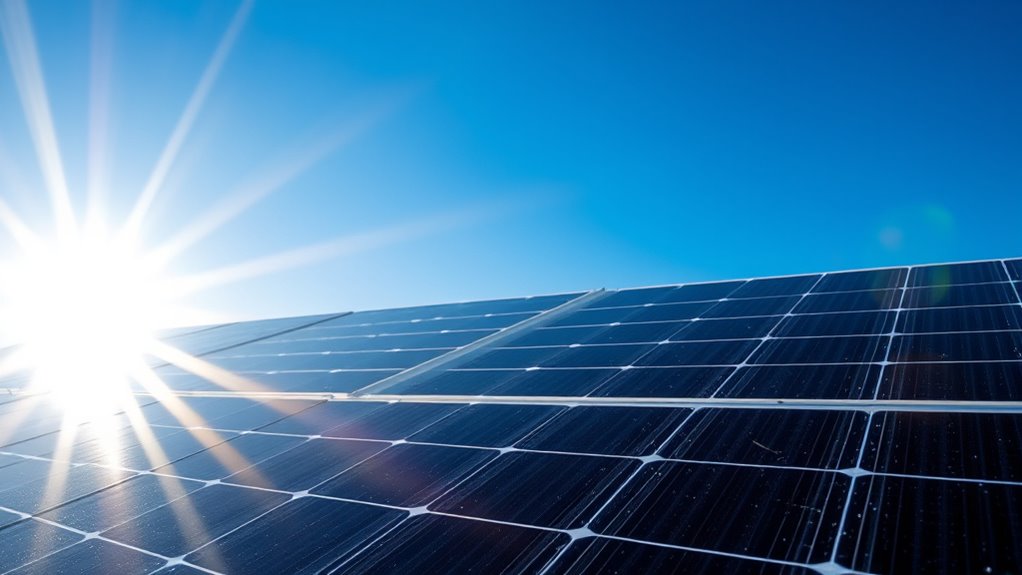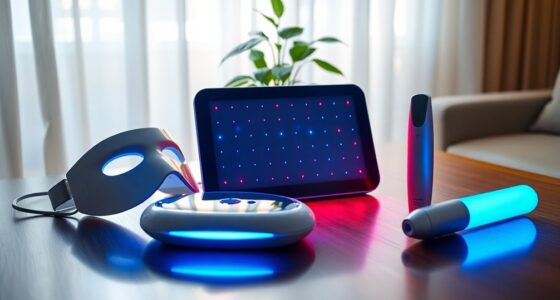Understanding irradiance is about recognizing how much sunlight hits a surface, measured in W/m². To estimate the power, multiply the area of your solar panel by the irradiance; for example, a 10 m² panel with 800 W/m² receives about 8,000 W. To find daily energy, multiply the peak power by sunlight hours, like 8 kW × 5 hours = 40 kWh. If you’re curious about optimizing solar energy, learn how these simple calculations connect sunlight to usable power.
Key Takeaways
- Solar irradiance is the sunlight power received per unit area, measured in W/m², influencing solar energy potential.
- Multiply panel area (m²) by irradiance (W/m²) to estimate maximum incident power in watts.
- Daily energy production can be approximated by multiplying peak power (kW) by sunlight hours (hours).
- Fluctuations in irradiance due to time, weather, and angle affect actual solar energy output.
- Understanding these simple calculations helps optimize solar system design and predict energy yields.

Have you ever wondered how sunlight translates into usable energy? When sunlight hits a surface, it carries energy known as solar irradiance. This term describes the amount of solar power received per unit area, usually expressed in watts per square meter (W/m²). Understanding irradiance helps you grasp how much energy is available for solar panels and other applications. Think of irradiance as the sunlight’s intensity at a specific moment and location. It varies throughout the day, with the highest values when the sun is directly overhead and lower values during morning, evening, or cloudy conditions. Recognizing these fluctuations is key to estimating how much energy your solar system can produce.
Sunlight’s energy, called solar irradiance, varies by time and location, affecting solar power potential.
To translate irradiance into usable energy, you need to examine the area exposed to sunlight. Suppose your solar panel has an area of 10 square meters and receives an average irradiance of 800 W/m² during peak hours. Multiplying these gives you the total power incident on your panel: 10 m² × 800 W/m² = 8,000 W or 8 kW. This calculation shows the potential maximum power your system could generate at that moment, assuming perfect conditions. However, in reality, various factors like shading, angle, and the panel’s efficiency reduce the actual energy output.
Energy production isn’t just about instantaneous power; it’s about how much energy accumulates over time. To estimate daily energy production, multiply the power received by the number of sunlight hours your location typically receives. For example, if your solar system produces 8 kW at peak sunlight and the sun shines directly for about 5 hours a day, your system could generate around 40 kWh daily (8 kW × 5 hours). This simple math helps you plan and understand how much energy you can expect from your solar setup. Keep in mind, though, that actual energy output will often be less due to inefficiencies and conditions like cloud cover.
Understanding the relationship between irradiance and energy allows you to optimize your solar systems better. By measuring irradiance levels and knowing the area of your panels, you can predict energy yields and adjust system components or installation angles accordingly. This knowledge empowers you to make smarter choices about solar investments, ensuring you maximize the energy you capture from the sun. Ultimately, grasping these basic calculations bridges the gap between raw sunlight and the energy that powers your home or business, making solar energy more accessible and manageable for you.
Frequently Asked Questions
How Does Weather Affect Solar Irradiance Levels?
Weather markedly impacts your solar irradiance levels. Cloud cover can block sunlight, reducing the amount of solar energy reaching your panels. Rain and snow can also diminish irradiance by scattering or absorbing sunlight. Conversely, clear sunny days boost irradiance, maximizing energy production. Wind and humidity can influence the atmosphere’s clarity, affecting how much sunlight penetrates. Overall, your local weather conditions directly determine how much solar energy your system can generate each day.
Can Irradiance Be Different at the Same Location Over Time?
Yes, irradiance can vary at the same location over time. In fact, it can change by up to 50% within a single day due to factors like the sun’s angle, weather, and atmospheric conditions. For example, during midday, irradiance peaks, but on cloudy days, it drops markedly. These fluctuations impact solar energy production and mean you’ll see different energy outputs even in the same spot at different times.
What’s the Difference Between Irradiance and Insolation?
Irradiance measures the solar power received per unit area at a specific moment, typically in watts per square meter, while insolation represents the total solar energy received over a period, like daily or yearly, measured in watt-hours per square meter. You can think of irradiance as a snapshot of sunlight intensity, whereas insolation sums that sunlight over time, giving you a broader view of solar energy availability for your needs.
How Is Energy Output Calculated From Irradiance Data?
Think of irradiance as a sunbeam’s punch, and energy output as the total harvest from that punch. To calculate it, you multiply the irradiance (power per area) by the area exposed and the time of exposure. This gives you the total energy in joules. By understanding this, you can estimate how much solar power your panels can generate over specific periods.
Are There Tools to Measure Irradiance Accurately?
Yes, you can measure irradiance accurately with tools like pyranometers and pyrheliometers. Pyranometers are widely used for measuring global solar irradiance on a flat surface, providing reliable data for solar energy projects. Pyrheliometers focus on direct sunlight, offering precise measurements of beam radiation. When choosing a tool, consider your specific needs, location, and budget to guarantee you get accurate, consistent readings for your solar assessments.
Conclusion
Now that you know how irradiance and energy work together, you’re practically a solar power wizard! With this simple math guide, you can confidently understand and calculate solar energy, turning you into the superhero of your own energy future. Remember, mastering these concepts is like revealing a secret superpower—soon, you’ll be making the sun work for you like never before. Keep practicing, and you’ll be shining brighter than the midday sun!









